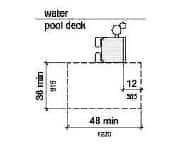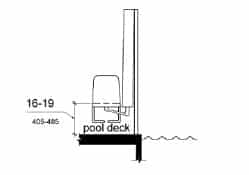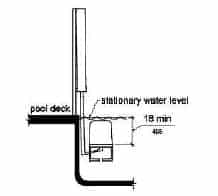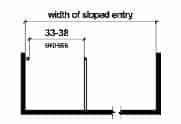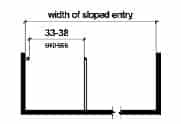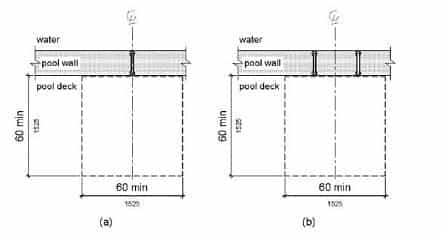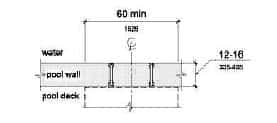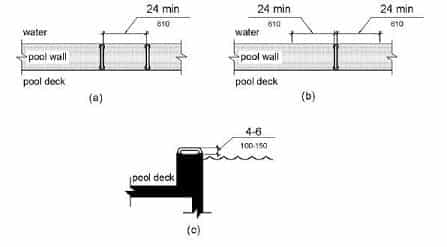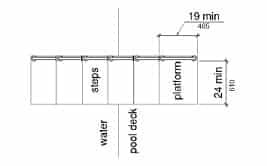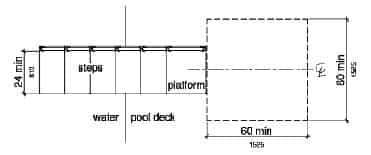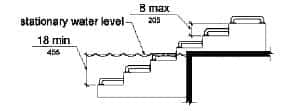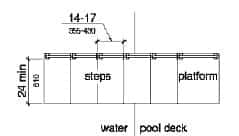ADA Pool Lift Laws
- Title II (Public Industry) municipal pools, school pools, government owned pools, etc.
- Title III (Private Industry) place of recreation, place of lodging, which addresses public accommodations
242.2 Swimming Pools. At least two accessible means of entry shall be provided for swimming pools. Accessiblemeans of entry shall be swimming pool lifts complying with 1009.2; sloped entries complying with 1009.3; transfer walls complying with 1009.4; transfer systems complying with 1009.5; and pool stairs complying with 1009.6. At least one accessible means of entry provided shall comply with 1009.2 or 1009.3. EXCEPTIONS: 1. Where a swimming pool has less than 300 linear feet (91 m) of swimming pool wall, no more than one accessible means of entry shall be required provided that the accessible means of entry is a swimming pool lift complying with 1009.2 or sloped entry complying with 1009.3. 2. Wave action pools, leisure rivers, sand bottom pools, and other pools where user access is limited to one area shall not be required to provide more than one accessible means of entry provided that the accessible means of entry is a swimming pool lift complying with 1009.2, a sloped entry complying with 1009.3, or a transfer system complying with 1009.5. 3. Catch pools shall not be required to provide an accessible means of entry provided that the catch pool edge is on an accessible route. Advisory 242.2 Swimming Pools. Where more than one means of access is provided into the water, it is recommended that the means be different. Providing different means of access will better serve the varying needs of people with disabilities in getting into and out of a swimming pool. It is also recommended that where two or more means of access are provided, they not be provided in the same location in the pool. Different locations will provide increased options for entry and exit, especially in larger pools. Advisory 242.2 Swimming Pools Exception 1. Pool walls at diving areas and areas along pool walls where there is no pool entry because of landscaping or adjacent structures are to be counted when determining the number ofaccessible means of entry required. 242.3 Wading Pools. At least one accessible means of entry shall be provided for wading pools. Accessible means of entry shall comply with sloped entries complying with 1009.3. 242.2 Swimming Pools. At least two accessible means of entry shall be provided for swimming pools. Accessible means of entry shall be swimming pool lifts complying with 1009.2; sloped entries complying with 1009.3; transfer walls 242.4 Spas. At least one accessible means of entry shall be provided for spas. Accessible means of entry shall comply with swimming pool lifts complying with1009.2; transfer walls complying with 1009.4; or transfer systems complying with 1009.5. EXCEPTION: Where spas are provided in a cluster, no more than 5 percent, but no fewer than one, spa in each cluster shall be required to comply with 242.4. 1009 Swimming Pools, Wading Pools, and Spas 1009.1 General. Where provided, pool lifts, sloped entries, transfer walls, transfer systems, and pool stairs shall comply with 1009. 1009.2 Pool Lifts. Pool lifts shall comply with 1009.2. Advisory 1009.2 Pool Lifts. There are a variety of seats available on pool lifts ranging from sling seats to those that are preformed or molded. Pool lift seats with backs will enable a larger population of persons with disabilities to use the lift. Pool lift seats that consist of materials that resist corrosion and provide a firm base to transfer will be usable by a wider range of people with disabilities. Additional options such as armrests, head rests, seat belts, and leg support will enhance accessibility and better accommodate people with a wide range of disabilities. 1009.2.1 Pool Lift Location. Pool lifts shall be located where the water level does not exceed 48 inches (1220 mm). EXCEPTIONS: 1. Where the entire pool depth is greater than 48 inches (1220 mm), compliance with 1009.2.1 shall not be required. 2. Where multiple pool lift locations are provided, no more than one pool lift shall be required to be located in an area where the water level is 48 inches (1220 mm) maximum. 1009.2.2 Seat Location. In the raised position, the centerline of the seat shall be located over the deck and 16 inches (405 mm) minimum from the edge of the pool. The deck surface between the centerline of the seat and the pool edge shall have a slope not steeper than 1:48.
1009.2.3 Clear Deck Space. On the side of the seat opposite the water, a clear deck space shall be provided parallel with the seat. The space shall be 36 inches (915 mm) wide minimum and shall extend forward 48 inches (1220 mm) minimum from a line located 12 inches (305 mm) behind the rear edge of the seat. The clear deck space shall have a slope not steeper than 1:48.
1009.2.4 Seat Height. The height of the lift seat shall be designed to allow a stop at 16 inches (405 mm) minimum to 19 inches (485 mm) maximum measured from the deck to the top of the seat surface when in the raised (load) position.
1009.2.5 Seat Width. The seat shall be 16 inches (405 mm) wide minimum. 1009.2.6 Footrests and Armrests. Footrests shall be provided and shall move with the seat. If provided, the armrest positioned opposite the water shall be removable or shall fold clear of the seat when the seat is in the raised (load) position. EXCEPTION: Footrests shall not be required on pool lifts provided in spas. 1009.2.7 Operation. The lift shall be capable of unassisted operation from both the deck and water levels. Controls and operating mechanisms shall be unobstructed when the lift is in use and shall comply with 309.4. Advisory 1009.2.7 Operation. Pool lifts must be capable of unassisted operation from both the deck and water levels. This will permit a person to call the pool lift when the pool lift is in the opposite position. It is extremely important for a person who is swimming alone to be able to call the pool lift when it is in the up position so he or she will not be stranded in the water for extended periods of time awaiting assistance. The requirement for a pool lift to be independently operable does not preclude assistance from being provided. 1009.2.8 Submerged Depth. The lift shall be designed so that the seat will submerge to a water depth of 18 inches (455 mm) minimum below the stationary water level.
1009.2.9 Lifting Capacity. Single person pool lifts shall have a weight capacity of 300 pounds. (136 kg) minimum and be capable of sustaining a static load of at least one and a half times the rated load. Advisory 1009.2.9 Lifting Capacity. Single person pool lifts must be capable of supporting a minimum weight of 300 pounds (136 kg) and sustaining a static load of at least one and a half times the rated load. Pool lifts should be provided that meet the needs of the population they serve. Providing a pool lift with a weight capacity greater than 300 pounds (136 kg) may be advisable. 1009.3 Sloped Entries. Sloped entries shall comply with 1009.3. Advisory 1009.3 Sloped Entries. Personal wheelchairs and mobility devices may not be appropriate for submerging in water. Some may have batteries, motors, and electrical systems that when submerged in water may cause damage to the personal mobility device or wheelchair or may contaminate the pool water. Providing an aquatic wheelchair made of non-corrosive materials and designed for access into the water will protect the water from contamination and avoid damage to personal wheelchairs or other mobility aids. 1009.3.1 Sloped Entries. Sloped entries shall comply with Chapter 4 except as modified in 1109.3.1 through 1109.3.3. EXCEPTION: Where sloped entries are provided, the surfaces shall not be required to be slip resistant. 1009.3.2 Submerged Depth. Sloped entries shall extend to a depth of 24 inches (610 mm) minimum and 30 inches (760 mm) maximum below the stationary water level. Where landings are required by 405.7, at least one landing shall be located 24 inches (610 mm) minimum and 30 inches (760 mm) maximum below the stationary water level. EXCEPTION: In wading pools, the sloped entry and landings, if provided, shall extend to the deepest part of the wading pool.
1009.3.3 Handrails. At least two handrails complying with 505 shall be provided on the sloped entry. The clear width between required handrails shall be 33 inches (840 mm) minimum and 38 inches (965 mm) maximum. EXCEPTIONS: 1. Handrail extensions specified by 505.10.1 shall not be required at the bottom landing serving a sloped entry. 2. Where a sloped entry is provided for wave action pools, leisure rivers, sand bottom pools, and other pools where user access is limited to one area, the handrails shall not be required to comply with the clear width requirements of 1009.3.3. 3. Sloped entries in wading pools shall not be required to provide handrails complying with 1009.3.3. If provided, handrails on sloped entries in wading pools shall not be required to comply with 505.
1009.4 Transfer Walls. Transfer walls shall comply with 1009.4. 1009.4.1 Clear Deck Space. A clear deck space of 60 inches (1525 mm) minimum by 60 inches (1525 mm) minimum with a slope not steeper than 1:48 shall be provided at the base of the transfer wall. Where one grab bar is provided, the clear deck space shall be centered on the grab bar. Where two grab bars are provided, the clear deck space shall be centered on the clearance between the grab bars.
1009.4.2 Height. The height of the transfer wall shall be 16 inches (405 mm) minimum and 19 inches (485 mm) maximum measured from the deck.
1009.4.3 Wall Depth and Length. The depth of the transfer wall shall be 12 inches (305 mm) minimum and 16 inches (405 mm) maximum. The length of the transfer wall shall be 60 inches (1525 mm) minimum and shall be centered on the clear deck space.
1009.4.4 Surface. Surfaces of transfer walls shall not be sharp and shall have rounded edges. 1009.4.5 Grab Bars. At least one grab bar complying with 609 shall be provided on the transfer wall. Grab bars shall be perpendicular to the pool wall and shall extend the full depth of the transfer wall. The top of the gripping surface shall be 4 inches (100 mm) minimum and 6 inches (150 mm) maximum above transfer walls. Where one grab bar is provided, clearance shall be 24 inches (610 mm) minimum on both sides of the grab bar. Where two grab bars are provided, clearance between grab bars shall be 24 inches (610 mm) minimum. EXCEPTION: Grab bars on transfer walls shall not be required to comply with 609.4.
1009.5 Transfer Systems. Transfer systems shall comply with 1009.5. 1009.5.1 Transfer Platform. A transfer platform shall be provided at the head of each transfer system. Transfer platforms shall provide 19 inches (485 mm) minimum clear depth and 24 inches (610 mm) minimum clear width.
1009.5.2 Transfer Space. A transfer space of 60 inches (1525 mm) minimum by 60 inches (1525 mm) minimum with a slope not steeper than 1:48 shall be provided at the base of the transfer platform surface and shall be centered along a 24 inch (610 mm) minimum side of the transfer platform. The side of the transfer platform serving the transfer space shall be unobstructed.
1009.5.3 Height. The height of the transfer platform shall comply with 1009.4.2. 1009.5.4 Transfer Steps. Transfer step height shall be 8 inches (205 mm) maximum. The surface of the bottom tread shall extend to a water depth of 18 inches (455 mm) minimum below the stationary water level. Advisory 1009.5.4 Transfer Steps. Where possible, the height of the transfer step should be minimized to decrease the distance an individual is required to lift up or move down to reach the next step to gain access.
1009.5.5 Surface. The surface of the transfer system shall not be sharp and shall have rounded edges. 1009.5.6 Size. Each transfer step shall have a tread clear depth of 14 inches (355 mm) minimum and 17 inches (430 mm) maximum and shall have a tread clear width of 24 inches (610 mm) minimum.
1009.5.7 Grab Bars. At least one grab bar on each transfer step and the transfer platform or a continuous grab bar serving each transfer step and the transfer platform shall be provided. Where a grab bar is provided on each step, the tops of gripping surfaces shall be 4 inches (100 mm) minimum and 6 inches (150 mm) maximum above each step and transfer platform. Where a continuous grab bar is provided, the top of the gripping surface shall be 4 inches (100 mm) minimum and 6 inches (150 mm) maximum above the step nosing and transfer platform. Grab bars shall comply with 609 and be located on at least one side of the transfer system. The grab bar located at the transfer platform shall not obstruct transfer. EXCEPTION: Grab bars on transfer systems shall not be required to comply with 609.4.
1009.6 Pool Stairs. Pool stairs shall comply with 1009.6. 1009.6.1 Pool Stairs. Pool stairs shall comply with 504. EXCEPTION: Pool step riser heights shall not be required to be 4 inches (100 mm) high minimum and 7 inches (180 mm) high maximum provided that riser heights are uniform. 1009.6.2 Handrails. The width between handrails shall be 20 inches (510 mm) minimum and 24 inches (610 mm) maximum. Handrail extensions required by 505.10.3 shall not be required on pool stairs. Questions and answers The Americans with Disabilities Act (ADA) is a civil rights law that prohibits discrimination on the basis of disability. On September 15, 2010, the ADA Guidelines finalized on July 23, 2004 (ADAAG 2004) were signed into law and now require compliance by all Title II (Public Entities) and Title III (Public Accommodations and Commercial Entities) by March 15, 2012. ADA regulations cover both public and private facilities including pools operated by public park and recreation districts, hotels and motels, fitness and recreational sports clubs, country clubs, high schools and universities, waterparks, hospitals and health care facilities. Regulations may also apply to private residential facilities, such as homeowners, apartment and condo associations, if these facilities are open to the general public. What is the deadline? All pools and spas completed after March 15 of 2011 must comply. While the law mentions something called safe harbor, or grandfathering, for facilities built to guidelines published in 1991, this does not apply to pools, spas and waterfeatures, because no earlier rules were available for those elements. Therefore, none are exempt from the new standard, and must comply by March 15, 2012. Some areas peripheral to the pool, such as decks, were covered by the 1991 guidelines. However, designers must abide by one standard for an entire facility. You can’t, for example, design the deck to the 1991 standard and the pool to the 2010 version. So, basically, anything involving a pool, spa or waterfeature must comply with the new law – and must do so by March 15, 2012. What does the new law require? The ADA states that all public pools must have a sloped entry or a lift. These are considered the primary forms of access. In addition, any commercial pool measuring more than 300 perimeter feet (with one exception discussed below) must have a second means of entry. This additional method can include a lift, ramp, transfer wall (a low wall with handles that helps people lift themselves over the side of the pool), a transfer system (which resembles a set of small portable stairs) or accessible pool stairs. In those pools that require two devices, the standard discourages against using the same method twice. Instead, installing different forms of access will address more diverse needs and, therefore, serve the most people. Pools where entry is limited to one area, such as wave pools and lazy rivers, are only required to have a single form of access – a lift, sloped entry or transfer – regardless of the vessel’s size. Wading pools must have a sloped entry. Nothing is required for catch pools, but there needs to be a clear route through the deck to the edge. Spas are to be outfitted with a lift, transfer wall or transfer system. When there is a group of spas, only 5 percent of the units are required to meet the standard, with a minimum of one complying. – The lift must have a solid seat of at least sixteen inches in width, with a footrest and armrests that can move out of the way when transferring. – The lift will transport a minimum of 300 lbs. at the seat, and the seat will stop above the deck in the transfer position between 16″ (min) and 19″ (max) above the deck. The lift will submerge the seat at least 18″ below the surface of the water to transfer into the pool. The lift will be operable by the user from either the deck or water regardless of the position of the chair. If a ramp or zero-depth entry is used, it must have a 1-to-12 slope, meaning that it takes 12 feet of run for the elevation to change 1 foot. It must land in water between 24- and 30 inches deep. If landings are required (as they are for any ramp longer than 30 feet), at least one must fall in the specified depth. Ramps can go deeper, as long as they have that landing in the 24- to 30-inch depth. In wading pools, the landing must end at the deepest part of the vessel. The sloped entry must have at least two handrails, spaced 33 to 38 inches apart. In wave pools, lazy rivers and other elements where access is limited to one area, the handrails don’t have to meet this requirement. Handrails are not required in wading pools. The 60-by-60-inch area of the deck leading into the zero-depth entry must be nearly flat – at a 1-to-48-foot slope. The law also includes specifications for transfer walls and transfer systems. Many facilities can receive a tax credit or deduction for upgrades to meet ADA requirements. Local governments and non-profits can’t reap this benefit, however, because they don’t pay taxes. Do the ADA requirements apply to all commercial pools? Yes and no. Large-scale pools those in universities, city parks and the like fall under the jurisdiction of the Department of Justice and, therefore, must comply. Hotels and motels also must fall within the standard. Those at apartment and condominium complexes and some private clubs are covered by the Fair Housing Act, so the ADA doesn’t apply. However, if the apartment or condo acts like a “public accommodation” by renting units out for vacationers, or selling entry or memberships for the pool to the public, then it does fall under the ADA. What signifies a property as a public accommodation? Pools under ADA Regulations fall under either: a. Title II (municipal pools, school pools, government owned pools, etc.) b. Title III (place of recreation, place of lodging), which addressees public Accommodations. Clear cut Title III facilities include: * Hotels and bed & breakfasts are two clear examples of public accommodations. These establishments are open to the public, actives rent out units when owners and/or tenants are absent. They also advertise and take reservations over the phone. The provision of meals and housekeeping services are also a characteristic of a public accommodation. * Timeshares and vacation homes that operate as a hotel have to comply. Although the ADDA does not affect private or residential property, such property can still be considered a public accommodation if it opens its doors to the public (nonmembers, non-residents) for use of the facilities: * Condominiums and homeowner associations are susceptible to having to comply with the ADAA. A good rule of thumb when trying to determine if a pool in a condominium or homeowner association would be considered a public accommodation and be required to comply, is: does it “act like a hotel,” renting out units when owners are absent, advertising such availability? * Private clubs, which are defined as having a restrictive membership policy and considerable dues, are typically not required to comply with ADA. However, if the pool is open too non-members then they must comply. Further, states can be more stringent if they so choose, Florida, for example, does not exclude private clubs from ADA requirements. More specifically, if any of the above mentioned entities allow: * Swim meets that allow outside members or non-residents: they could be required to comply during those hour’s of use where the facilities were being used by the public. Investment off a portable pool lift would provide as a sufficient solution to the problem at hand, could even be rented for that tie period only. * Pool memberships that are purchased by non-residents: This affects some apartment complexes, condominiums, as well as various homeowners associations. Thee memberships would allow the public to use the available facilities, making it a public accommodation. The general rule is if a pool is open to a body of people outside of the general membership or nonresidents, the pool is considered a public accommodation during this length of time. However, if the private club or homeowner/condominium association member has guests visiting them this does not require compliance. For example, if a function such as a birthday party takes place on one of these properties and non-members or non-residents are invited too attend, compliance should not be required.


